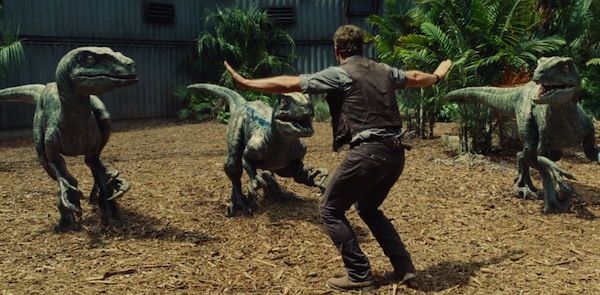Some writers love compiling lists about “Why movies are so terrible today”—as opposed to back when they were great, before digital or widescreen or color or sound or whatever other technological development.
CGI, or computer-generated imagery, is the villain in two widely circulated posts. A month ago on the Cracked website David Christopher Bell gave 6 Reasons Modern Movie CGI Looks Surprisingly Crappy, which basically boiled down to how Bell liked movies better when they used a lot of animatronics.
On Rocketstock, Michael James has 10 Reasons Why CGI is Getting Worse, Not Better.
After bemoaning the death of 35mm, I’m as surprised as you are to find myself defending CGI. But both Bell and James are complaining about filmmakers who misuse a tool, not how the tool itself is a problem.
Let’s take James point by point:
1. CGI has transitioned from a complimentary dish to the main course. (Is it poor form to point out James should have used “complementary”?) Essentially #1 comes down to filmmakers use too much CGI instead of animatronics, like in Jurassic Park. But you could just as easily say that way back when Filmmaker X used too much stop motion, or too much wire work, or too much any special effect. The frequency of use has nothing to do with whether or not the tool is bad.
2. The physics are off. “Scenes from movies like Matrix Reloaded or Catwoman showcase stunts that are impossible to perform with an actual human.” First off, they’re not humans, they’re superheroes or avatars or whatever. Second, look at any barroom brawl in a big-budget 1940s Western and ask yourself who could survive falling off a balcony onto a poker table? Who could trade blow after blow without suffering broken jaws, ribs, hands, internal bleeding? Who could take four or five slugs to the body and still save the day?
I agree that many action scenes in big-budget blockbusters are poorly designed, poorly shot, and especially poorly edited. But that’s not the fault of CGI.
I love filmmakers like Tsui Hark or action choreographers like Corey Yuen who insert close-ups of an actor’s foot pushing off a beam as if that were proof he could leap up three stories, land on a railing, and kick some guy in the face. I love movies where heroes jump onto horses and slide under stagecoaches, but even when it’s Yakima Canutt there are special effects being used: undercranking, mattes, padding, etc.
3. CGI has put us in a state of denial. Hmm, hard to argue with this point as it doesn’t make any sense. I guess he’s saying filmmakers use CGI too much, which is the same as #1. But given the right budget, everyone uses CGI. Filmmakers like Woody Allen and Alexander Payne use CGI. I dare you to show where they are used in Nebraska, for example.
Here’s one effects worker describing how pervasive CGI are:
Last year I had a project where I had to add stars to the night shots because they weren’t visible. And I had to do a shot of a rattlesnake because it had to go in a certain direction. And in one scene I had to add two hummingbirds flitting around in the background. I also had to add some rain to a shot where the on-set sprinklers weren’t powerful enough.
In other words, CGI as a tool, not the death of cinema as we know it.
4. The move to HD and 4K make CGI less convincing. I guess digitizing The Wizard of Oz didn’t compromise any of its special effects.
5. Stylized grades and CGI don’t mix. James doesn’t like contemporary color schemes. Too bad, but color grading has nothing to do with CGI.
6. There’s no restraint. Didn’t he already say this in #1 and 3?
7. CGI-driven action is sequel-oriented. Memo to James: any big-budget Hollywood action movie is sequel-oriented. They’ve been that way for decades, well before CGI came into play.
8. CGI is dangerous. James doesn’t really prove this point, unless he’s making an indirect reference to stressed-out Koreans or Indians whose effects shops are unable to meet deadlines. Otherwise, another rehash of 1, 3, and 6.
9. CGI encourages lazy filmmaking. Hey, trade out “CGI” for just about anything—sound, color, stop motion, mattes, back projection, stunt doubles, insert shots, post-dubbing, second units, reshoots—and this statement is just as accurate. Filmmakers don’t need CGI to be lazy, they can be lazy on their own.
10. CGI has made us complacent. CGI is like heroin? What does that make Technocranes or Steadicams?
James uses this point to complain about big action scenes that leave us “less impressed with real life situations and settings.” Except that filmmakers are using CGI in exactly those real-life situations and settings, like The Blind Side, McFarland USA, the upcoming Everest. James can complain all he wants about “lame” action, but it’s sheer laziness to blame bad writing, directing, and editing solely on CGI.
If someone wants to write about how CGI are putting X, Y, or Z out of work, or are polluting the environment, or caused performer A to break a leg, or lead to blindness, fine, I’m prepared to listen. But if you just want to complain about comic book movies or sequels or bad action sequences or “crazy” looking colors, find another scapegoat.




